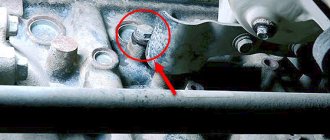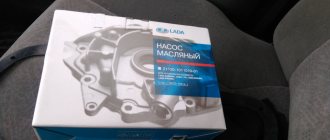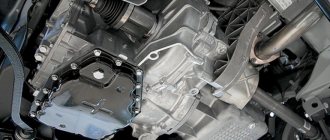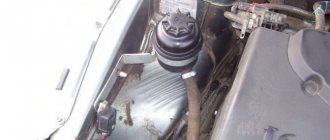Motor oils are a thick liquid mixture of base oils and additives intended for the lubrication system of internal combustion engines.
Motor oil is a very important element. The quality of lubrication of all rubbing surfaces in the engine, as well as the period during which the oil retains its properties, depends on the quality of the engine oil.
Each car, each engine has its own recommended oils. This data is indicated by the manufacturer in the vehicle's operating manual.
There are three types of oils. Mineral, synthetic and semi-synthetic. Mineral oils are obtained by distilling petroleum. Synthetic - by organic synthesis. This is more complicated, which is why synthetics are significantly more expensive than mineral water (if you take one oil manufacturer). Semi-synthetic is, roughly speaking, mineral oil plus synthetic components.
The viscosity of the oil is indicated on the packaging (canister). For example, 5W30, where W means the oil is all-season, 5 is the viscosity at low temperatures, and 30 at high temperatures.
Low temperature viscosity is easy to calculate. It is necessary to subtract 35. 0W is used up to -35°С 5W up to -30°С 10W up to -25°С 15W up to -20°С 20W up to -15°С
High temperature viscosity is more difficult to calculate. Here you need to take into account a combination of many factors. It shows the viscosity at operating temperature, 100 - 150 degrees. The higher the value, the higher the viscosity.
All tolerances are indicated by the manufacturer in the motor oil tolerance table.
Here are the approvals for the Lada Vesta car:
What kind of oil to fill in and which manufacturer to choose is up to the car owner to decide. More expensive oil is not always better quality. Here, as they say, it comes down to taste and color. But it’s worth remembering that expensive brands are often counterfeited. There is still an opinion that synthetic motor oil is preferable for new cars.
For example, we took Rosneft Premium 5W40 for Vesta at TO-0. Purchased at an official Rosneft gas station to prevent counterfeiting. The Vesta engine was filled with Rosneft 5w30 service oil from the factory. Whether or not to do TO-0 is also up to the car owner to decide for himself. We decided to play it safe and drain the factory one and fill it with a new one after 3000 km, after running-in.
The engine oil change interval is set by the factory. At AvtoVAZ they believe that changing the oil every 15 thousand is enough. It is more correct to calculate the interval not by mileage, but by engine hours and operating conditions. Since in Russia it is hot in summer and cold in winter, there is a lot of sand, dust, uneven terrain, and so on, it is better to change it every 10 thousand mileage, or even 8 thousand. But everyone decides for themselves.
DSC_9521 (Copy)
If there is no puller, we pierce the filter housing with a screwdriver (closer to the bottom, so as not to damage the engine fitting) and unscrew the filter, using the screwdriver as a lever. We clean the filter seat on the cylinder block from dirt and oil drips. Fill the filter with new engine oil to approximately half the filter volume and apply a thin layer of oil to the filter O-ring. We wrap the oil filter by hand until the sealing ring comes into contact with the cylinder block. Turn the filter another 3/4 turn to seal the connection. Pour 4.4 liters of oil into the engine through the oil filler neck.
Attention! If your car is equipped with AMT, then the engine lubrication system capacity is approximately 3.2 liters.
Manual transmission 2190
A manual transmission that started its journey on the assembly line together with the release of the Lada Granta. In terms of its ideology, it is almost a complete clone of previous manual gearboxes from Lada, however, there are differences from the old models and the assembled gearbox from the tens or nines will not fit. Firstly, Granta has its own gearbox housing, which some craftsmen call the “bell”. Secondly, the principle of placement of the speed sensor is different; in old gearboxes there was a shaft for the speed indicator, but since with the arrival of the Lada Grant on the assembly line, AvtoVAZ began to switch to a different car control bus and the speed sensor 2190 is already built into the gearbox and only an electrical contact comes out.
Otherwise, in terms of its internal parts, the mechanism is completely identical. Despite its excellent reliability, it has a number of fatal drawbacks: low vibration comfort, poor selectivity of gear selection, large lever strokes.
At the moment, it is not used on Lada cars; it has been replaced by manual transmission 2181, which will be discussed further.
DSC_9613 (Copy)
Screw on the oil filler cap. We start the engine for 1–2 minutes. We make sure that the indicator of insufficient (emergency) oil pressure in the engine in the instrument cluster has gone out and there are no leaks from under the drain plug or from under the filter. We stop the engine and after a few minutes (so that the oil has time to drain into the oil pan) check the oil level in the oil pan. If necessary, bring the oil level to normal, tighten the oil filter and the drain plug.
Part size
To choose the optimal fret cap for the Vesta, you need to know its size. For each car, a hole of a different size is made in the crankcase, therefore, the plug is also selected individually for each model. The standard drain plug installed on the car has a thread measuring 16*1.5.
The size of the seals matters. A mismatch in diameter may result in engine fluid leakage.
Lada Vesta seal dimensions:
— diameter from the inside is 14.4 millimeters;
— outside diameter 20.2 millimeters;
— thickness 2 millimeters.
Automatic Jatco
For the first time, boxes of this type debuted on the Lada Granta, and later the Lada Kalina also received it. Unlike all other gearboxes, the Jatco automatic transmission has nothing to do with the developments of AvtoVAZ; the manufacturer of this gearbox is Japan, a company that is a long-time supplier of gearboxes for Nissan cars. So it happened this time, the automatic transmission that suited the Granta was installed on the Nissan Micra, however, it is worth noting that when installing it on the Granta, the engineers made numerous modifications and calibrations of both the gearbox itself and the car. Since this gearbox is much heavier than a manual transmission, it was necessary to change the car’s engine crankcase, suspension elements and mountings of the power unit. At the same time, the vehicle's ground clearance decreased from 160mm to 145mm. They installed a new type of cooling radiator with a block for cooling the gearbox oil; later, a radiator of this type began to be installed on other Grants, in which the oil cooler block was used for the operation of the air conditioning system. In general, the Jatco automatic transmission is a classic representative of torque converter automatic transmissions. It is based on four full stages and an imitation of the fifth, which is achieved by blocking the torque converter. The distinctive features of this transmission are that it ensures the smooth running of cars at a higher level and is devoid of the signature operating noise of VAZ gearboxes.
The fine-tuning of the software part of the new box was carried out by the Austrian company AVL, whose task was to optimally select operating modes to suit AvtoVAZ’s requirements. And the requirements were simple: the car must retain the dynamic character that the VAZ 21126 engine provides and obtain such smooth gear shifting that the driver will not even notice the transition to a higher gear. Based on reviews from owners of cars with a similar transmission, we can say with confidence that the work was done exactly as required by the car factory.
However, this solution also has disadvantages. Firstly, transmissions of this type, by definition, consume more fuel due to design features. Secondly, the gearbox is dead-end, it digests exactly as much torque as the VAZ 21126 engine produces, and it was not possible to install it on a more powerful VAZ 21127 engine. Thirdly, cars with an automatic transmission of this type are much more expensive than versions with a manual or robotic gearbox.
The gearbox is designed for an inexperienced owner; a large number of protection systems have been introduced into its control program. For example, if, when moving forward in a straight line, you move the gear selector to position R, which implies moving in reverse, the gearbox will ignore this action until the operating conditions change, allowing you to engage reverse.
Although service statistics at this point in time indicate that Japanese gearboxes are quite reliable and there are minimal complaints about their failure.
Over time, the number of trim levels equipped with such a transmission decreased due to the appreciation of the currency and, as a result, the increase in the cost of an automatic transmission. There was a time when AvtoVAZ completely removed the Lada Granta with a similar gearbox from the line of models. However, now the car plant offers Lada Granta and Lada Kalina with a Jatco gearbox, although in very limited configurations.
Consequences of untimely replacement with Lada Vesta
Operation without changing the oil on time can result in expensive repairs. There are many malfunctions caused by this operating mode. The most common defects include the following problems:
- Rotate the connecting rod bearings. This is due to the fact that the used oil becomes viscous and contains a large amount of dirt, soot and impurities. The sticky substance clogs the oil passages. Because of this, the load on the connecting rods increases significantly. The engine begins to heat up more and overheats, which may cause the connecting rod bearings to rotate.
- Turbocharger failure. This is true for cars that have been tuned and have a “turbo kit” system installed on them. Due to used oil, the bearings and rotor wear out faster, the shaft fails, and deep scratches appear on it, interfering with normal operation. Grooves may form and the bearings will gradually fail. Because of this, the turbocharger housing is often damaged. Seizing may occur if the oil passages become clogged with oil.
- Wear of individual engine parts. Most often, premature wear occurs precisely because of poor quality lubricant or untimely replacement. This also happens if the engine oil has too low a viscosity. Because of this, the oil film, which should be on the cylinder walls and protect them from friction by the piston, either breaks or does not have time to form at all. This leads to the fact that there is no neutralization of soot and other harmful compounds, for example, acidic ones, which are formed during fuel combustion. In the complete absence of lubrication, increased wear of parts will also occur, but there is a risk that the engine will completely seize. If the quality of the oil deteriorates, this will not happen, but the engine will experience increased loads. Individual parts will overheat, some may even melt completely or partially. Failure to comply with oil change intervals most often results in bending or destruction of valves. Gas will leave the combustion chamber and you will feel a loss of traction.
The consequences of non-compliance with the replacement interval can be very significant, since the oil not only reduces the intensity of friction between internal combustion engine parts, but also reduces heating.
How to check the oil in the box
We place the car in a viewing hole, on a roadside overpass. Using the key “14” we unscrew the level control plug; it is located identically in the automatic transmission and manual transmission.
If the oil starts to flow when the plug is open, it means the level is sufficient. Otherwise, replenish the missing amount using a hose and funnel.
Conclusion Do not exceed the maintenance period, do not pour oil above the level on the control plug. An excess amount of liquid contributes to an increase in pressure in the system, deformation of sealing gaskets, seals, and depressurization of the system.
AMT 2182
In an effort to make its own “automatic” and at the same time not to exceed the limits of a low budget, AvtoVAZ launched an automated manual transmission into series. Figuratively speaking, this is a manual gearbox, in which the role of gear shifting is given to the actuator. But is it so simple, let's figure it out.
The main components and assemblies were taken from the modernized manual transmission that we talked about earlier; its characteristics are fully suitable for the tasks that AvtoVAZ sets for its cars. The shift mechanism was developed by ZF, which is famous for its quality solutions in the world of transmission development. According to the manufacturer, the service life of the switching unit is at least ten years; all wiring, terminals and the control board are reliably protected from dust, moisture and low temperatures, which made it possible to expand the temperature range of use of the gearbox.
At first glance, it seems that such a solution has exactly the same properties as the classic hydromechanical automatic machine, which we will talk about later. The car has two pedals, an accelerator and a brake, the gearshift lever has modes N - neutral, A - automatic switching, R - reverse mode and M - manual or manual mode. However, the operation of a robotic box has its differences and advantages. The main difference for the driver is that the robotic gearbox cannot be kept on the brake for a long time in automatic mode, this can lead to overheating of the clutch, which will be indicated by the indicator on the dashboard. In long traffic jams, it is better to move the gearbox selector to the neutral position. Manual transmission also does not have a “creeping” mode, when when you release the brake pedal the car rolls forward on its own. AvtoVAZ engineers did not provide such a function in order to extend the service life of the clutch, since the mode when the car starts to move when the clutch pedal is released has a detrimental effect on the mechanism.
Apart from these features, everything else is an advantage of robotic gearboxes - they are simpler and cheaper to maintain, help save fuel due to the absence of losses in the hydromechanical actuator, they can be towed and driven out of difficult places using rocking back and forth.
Among other things, the designers and engineers who took part in the development of the new design laid out a training program. The car, analyzing the owner's driving style, adjusts the operation of the robotic gearbox. In total, the control unit contains twelve different control programs, sufficient to ensure operating comfort in any operating mode: city or sports.
In the future, all components and assemblies of the new gearbox should have a longer service life, unlike its mechanical counterpart. The reason for this is the electric gear shift mechanisms, which perform all operations smoothly and always as accurately and correctly as possible for the tasks at hand. While on a manual gearbox, excessive loads are possible if the owner is not experienced or if the desired gear is incorrectly selected and it is engaged too abruptly.
The new transmission from AvtoVAZ will be an excellent choice for a novice driver; it will significantly simplify the process of driving due to the absence of the need to depress the clutch and change gears, while a car with an AMT is initially cheaper than a similar one with an automatic transmission and in case of repair it will not be much more expensive than a conventional manual one transmissions.











